The Role of La2O3 in Enhancement the Radiation Shielding Efficiency of the Tellurite Glasses: Monte-Carlo Simulation and Theoretical Study
Abstract
:1. Introduction
2. Materials and Methods
3. Results and Discussion
3.1. Linear and Mass Attenuation Coefficients
3.2. The Transmission Factor
3.3. Half-Value Layer
3.4. Mean Free Path
3.5. Effective and Equivalent Atomic Number
3.6. Buildup Factors
4. Conclusions
Author Contributions
Funding
Institutional Review Board Statement
Informed Consent Statement
Data Availability Statement
Conflicts of Interest
Abbreviations
| LAC | Linear attenuation coefficient | diff (%) | The difference between simulated and computed values of MAC |
| I | Incoming intensity | Zeff | Effective atomic number |
| Io | Transmitted intensity | Zeq | Equivalent atomic number |
| MAC | Mass attenuation coefficient | EBF | Exposure buildup factor |
| TF | Transmission factor | EABF | Energy absorption buildup factor |
| HVL | Half-Value layer | PD | Penetration depth |
| ρ | Density of the examined material | ||
| ΣR | Neutron cross-section |
References
- Kulali, F. Simulation studies on radiological parameters for marble concrete. Emerg. Mater. Res. 2020, 9. [Google Scholar] [CrossRef]
- Mhareb, M.H.A. Physical, optical and shielding features of Li2O–B2O3–MgO–Er2O3 glasses co-doped of Sm2O3. Appl. Phys. A 2020, 126, 71. [Google Scholar] [CrossRef]
- Alaylar, B.; Aygün, B.; Turhan, K.; Karadayi, G.; Şakar, E.; Singh, V.P.; Sayyed, M.I.; Pelit, E.; Karabulut, A.; Güllüce, M.; et al. Characterization of gamma-ray and neutron radiation absorption properties of synthesized quinoline derivatives and their genotoxic potential. Radiat. Phys. Chem. 2021, 184, 109471. [Google Scholar] [CrossRef]
- Alsaif, N.A.M.; Alotiby, M.; Hanfi, M.Y.; Sayyed, M.I.; Mahmoud, K.A.; Alotaibi, B.M.; Alyousef, H.A.; Al-Hadeethi, Y. A comprehensive study on the optical, mechanical, and radiation shielding properties of the TeO2–Li2O–GeO2 glass system. J. Mater. Sci. Mater. Electron. 2021, 32, 15226–15241. [Google Scholar] [CrossRef]
- Hanfi, M.Y.; Yarmoshenko, I.V.; Ilgasheva, E.O.; Onishchenko, A.D.; Seleznev, A.A.; Ryanskaya, A.D. Gross alpha activity in urban sediments as an important indicator of urban environmental processes on the example of three Russian cities. J. Environ. Manag. 2021, 294, 113011. [Google Scholar] [CrossRef] [PubMed]
- Sayyed, M.I.; Almuqrin, A.H.; Ashok, K.; Jecong, J.F.M.; Akkurt, I. Optical, mechanical properties of TeO2-CdO-PbO-B2O3 glass systems and radiation shielding investigation using EPICS2017 library. Optik 2021, 242, 167342. [Google Scholar] [CrossRef]
- Sayyed, M.I.; Askin, A.; Zaid, M.H.M.; Olukotun, S.F.; Khandaker, M.U.; Tishkevich, D.I.; Bradley, D.A. Radiation shielding and mechanical properties of Bi2O3–Na2O–TiO2–ZnO–TeO2 glass system. Radiat. Phys. Chem. 2021, 186, 109556. [Google Scholar] [CrossRef]
- Alajerami, Y.S.; Drabold, D.; Mhareb, M.H.A.; Cimatu, K.L.A.; Chen, G.; Kurudirek, M. Radiation shielding properties of bismuth borate glasses doped with different concentrations of cadmium oxides. Ceram. Int. 2020, 46, 12718–12726. [Google Scholar] [CrossRef]
- Sayyed, M.I.; Al-Hadeethi, Y.; Al Shammari, M.M.A.; Al-Heniti, S.H.; Rammah, Y.S. Physical, optical and gamma radiation shielding competence of newly borotellurite based glasses: TeO2–B2O3–ZnO–Li2O3–Bi2O3. Ceram. Int. 2021, 47, 611–618. [Google Scholar] [CrossRef]
- Burak, A.; Bünyamin, A.; Kadir, T.; Gokce, K.; Erdem, S.; Singh, V.P.; Sayyed, M.I.; Emel, P.; Abdulhalik, K.; Medine, G.; et al. Characterization of gamma-ray and neutron radiation absorption properties of synthesized quinoline derivatives and their genotoxic potential. Radiat. Phys. Chem. 2021, 184, 109471. [Google Scholar]
- Bünyamin, A.; Burak, A.; Kadir, T.; Erdem, Ş.; Mehmet, K.; Sayyed, M.I.; Emel, P.; Medine, G.; Abdulhalik, K.; Zuhal, T.; et al. Investigation of neutron and gamma radiation protective characteristics of synthesized quinoline derivatives. Int. J. Radiat. Biol. 2020, 96, 1423–1434. [Google Scholar]
- Akkurt, I.; Basyigit, C.; Kilincarslan, S.; Mavi, B.; Akkurt, A. Radiation shielding of concretes containing different aggregates. Cem. Concr. Compos. 2006, 28, 153–157. [Google Scholar] [CrossRef]
- Kurtulus, R.; Kavas, T.; Akkurt, I.; Gunoglu, K. An experimental study and WinXCom calculations on X-ray photon characteristics of Bi2O3- and Sb2O3-added waste soda-lime-silica glass. Ceram. Int. 2020, 46, 21120–21127. [Google Scholar] [CrossRef]
- El-Khayatt, A.M.; Akkurt, I. Photon interaction, energy absorption and neutron removal cross-section of concrete including marble. Ann. Nucl. Energy 2013, 60, 8–14. [Google Scholar] [CrossRef]
- Yasmin, S.; Barua, B.S.; Khandaker, M.U.; Rashid, M.A.; Bradley, D.A.; Olatunji, M.A.; Kamal, M. Studies of ionizing radiation shielding effectiveness of silica-based commercial glasses used in Bangladeshi dwellings. Results Phys. 2018, 9, 541–549. [Google Scholar] [CrossRef]
- Divina, R.; Marimuthu, K.; Mahmoud, K.A.; Sayyed, M.I. Physical and structural effect of modifiers on dysprosium ions incorporated boro-tellurite glasses for radiation shielding purposes. Ceram. Int. 2020, 46, 17929–17937. [Google Scholar] [CrossRef]
- Almuqrin, A.H.; Sayyed, M.I. Radiation shielding characterizations and investigation of TeO2–WO3–Bi2O3 and TeO2–WO3–PbO glasses. Appl. Phys. A. 2021, 127, 190. [Google Scholar] [CrossRef]
- Sayyed, M.I.; Mahmoud, K.A.; Lacomme, E.; Al Shammari, M.M.; Dwaikat, N.; Alajerami, Y.S.M.; Alqahtani, M.; El-Bashir, B.O.; Mhareb, M.H.A. Development of a novel MoO3-doped borate glass network for gamma-ray shielding applications. Eur. Phys. J. Plus 2021, 136, 108. [Google Scholar] [CrossRef]
- Singh, V.P.; Badiger, N.M.; Chanthima, N.; Kaewkhao, J. Evaluation of gamma-ray exposure buildup factors and neutron shielding for bismuth borosilicate glasses. Radiat. Phys. Chem. 2014, 98, 14–21. [Google Scholar] [CrossRef]
- Sayyed, M.I.; Jecong, J.F.M.; Hila, F.C.; Balderas, C.V.; Alhuthali, A.M.; Guillermo, N.R.D.; Al-Hadeethi, Y. Radiation shielding characteristics of selected ceramics using the EPICS2017 library. Ceram. Int. 2021, 47, 13181–13186. [Google Scholar] [CrossRef]
- Sayyed, M.I.; Dong, M.G.; Tekin, H.O.; Lakshminarayana, G.; Mahdi, M.A. Comparative investigations of gamma and neutron radiation shielding parameters for different borate and tellurite glass systems using WinXCom program and MCNPX code. Mater. Chem. Phys. 2018, 215, 183–202. [Google Scholar] [CrossRef]
- Lakshminarayana, G.; Elmahroug, Y.; Kumar, A.; Dong, M.G.; Lee, D.E.; Yoon, J.; Park, T. TeO2–B2O3–ZnO–La2O3 glasses: γ-ray and neutron attenuation characteristics analysis by WinXCOM program, MCNP5, Geant4, and Penelope simulation codes. Ceram. Int. 2020, 46, 16620–16635. [Google Scholar] [CrossRef]
- Şakar, E.; Özgür, F.Ö.; Bünyamin, A.; Sayyed, M.I.; Murat, K. Phy-X/PSD: Development of a user friendly online software for calculation of parameters relevant to radiation shielding and dosimetry. Radiat. Phys. Chem. 2020, 166, 108496. [Google Scholar] [CrossRef]
- Mhareb, M.H.A.; Slimani, Y.; Alajerami, Y.S.; Sayyed, M.I.; Lacomme, E.; Almessiere, M.A. Structural and radiation shielding properties of BaTiO3 ceramic with different concentrations of Bismuth and Ytterbium. Ceram. Int. 2020, 46, 28877–28886. [Google Scholar] [CrossRef]
- Bantan, R.A.R.; Sayyed, M.I.; Mahmoud, K.A.; Al-Hadeethi, Y. Application of experimental measurements, Monte Carlo simulation and theoretical calculation to estimate the gamma ray shielding capacity of various natural rocks. Prog. Nucl. Energy 2020, 126, 103405. [Google Scholar] [CrossRef]
- Kaur, R.; Khanna, A.; Barriuso, M.G.; González, F. Structural, thermal and optical characterization of co-existing glass and anti-glass phases of xLa2O3-(100-x)TeO2 and 2TiO2-xLa2O3-(98-x)TeO2 systems. J. Non Cryst. Solids 2020, 540, 120117. [Google Scholar] [CrossRef]
- X-5 Monte Carlo Team. MCNP-A General Monte Carlo N-Particle Transport Code, Version 5; LA-CP-03–0245; Los Alamos Controlled Publication: Oak Ridge, TN, USA, 2003. [Google Scholar]
- Tekin, H.O.; Issa, S.A.M.; Mahmoud, K.A.A.; El-Agawany, F.I.; Rammah, Y.S.; Susoy, G.; Al-Buriahi, M.S.; Abuzaid, M.M.; Akkurt, I. Nuclear radiation shielding competences of Barium (Ba) reinforced borosilicate glasses. Emerg. Mater. Res. 2020, 9, 1131–1144. [Google Scholar] [CrossRef]
- Albarzan, B.; Hanfi, M.Y.; Almuqrin, A.H.; Sayyed, M.I.; Alsafi, H.M.; Mahmoud, K.A. The influence of titanium dioxide on silicate-based glasses: An evaluation of the mechanical and radiation shielding properties. Materials 2021, 14, 3414. [Google Scholar] [CrossRef]
- Akkurt, I. Effective atomic and electron numbers of some steels at different energies. Ann. Nucl. Energy 2009, 36, 1702–1705. [Google Scholar] [CrossRef]
- Akkurt, I.; Altindag, R.; Gunoglu, K. Photon attenuation coefficients of concrete including marble aggregates. Ann. Nucl. Energy 2012, 43, 56–60. [Google Scholar] [CrossRef]
- Eyecioğlu, Ö.; El-Khayatt, A.M.; Karabul, Y.; Çağlar, M.; Toker, O.; İçelli, O. BXCOM: A software for computation of radiation sensing. Radiat. Eff. Defects 2019, 174, 506–518. [Google Scholar] [CrossRef]
- Kurtulus, R.; Kavas, T.; Akkurt, I.; Gunoglu, K. Theoretical and experimental gamma-rays attenuation characteristics of waste soda-lime glass doped with La2O3and Gd2O3. Ceram. Int. 2020, 47, 8424–8432. [Google Scholar] [CrossRef]
- Kavaz, E.; Ghanim, E.H.; Abouhaswa, A.S. Optical, structural and nuclear radiation security properties of newly fabricated V2O5-SrO-PbO glass system. J. Non Cryst. Solids 2020, 538, 120045. [Google Scholar] [CrossRef]
- Berger, M.J.; Hubbel, J.H. XCOM: Photon Cross Sections Database, Gaithersburg, MD, USA. 1987. Available online: http://physics.nist.gov/xcom (accessed on 11 June 2021).
- Alsaif, N.A.M.; Alotiby, M.; Hanfi, M.Y.; Mahmoud, K.A.; Al-Yousef, H.A.; Alotaibi, B.M.; Sayyed, M.I. Comprehensive study of radiation shielding and mechanical features. J. Aust. Ceram. Soc. 2021. [Google Scholar] [CrossRef]
- Singh, K.J.; Singh, N.; Kaundal, R.S.; Singh, K. Gamma-ray shielding and structural properties of PbO–SiO2 glasses. Nucl. Instrum. Methods Phys. Res. B 2008, 266, 944–948. [Google Scholar] [CrossRef]


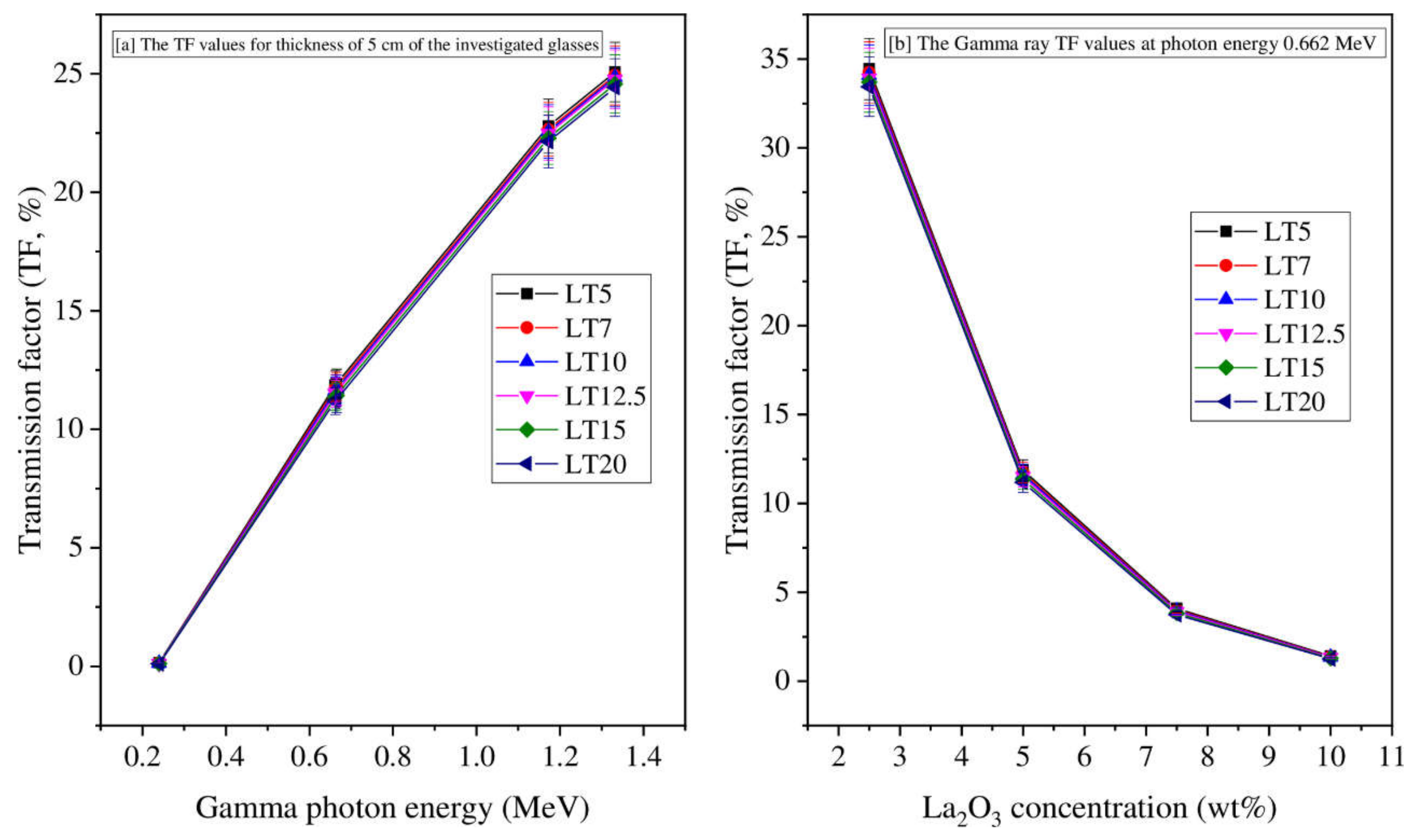
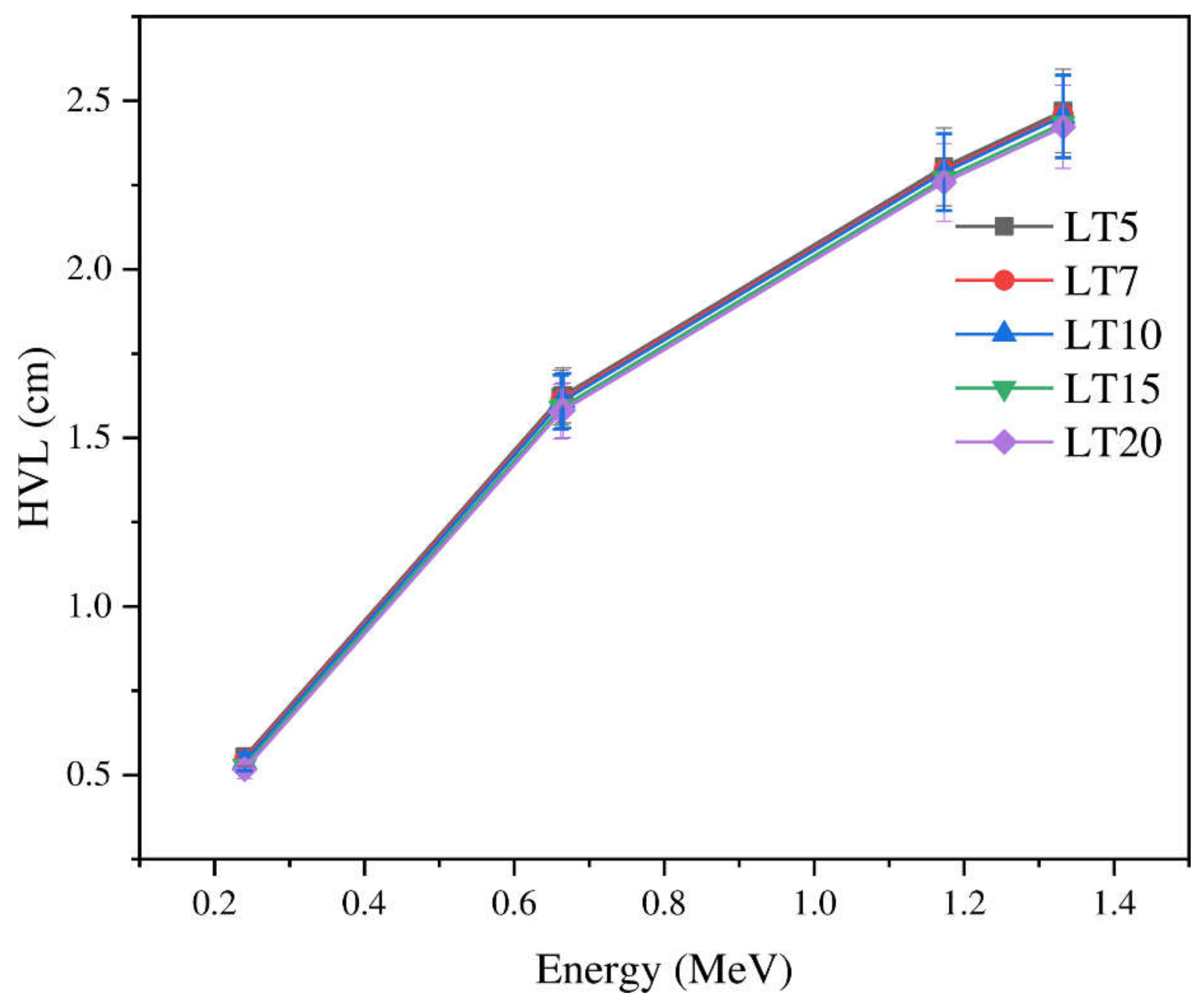
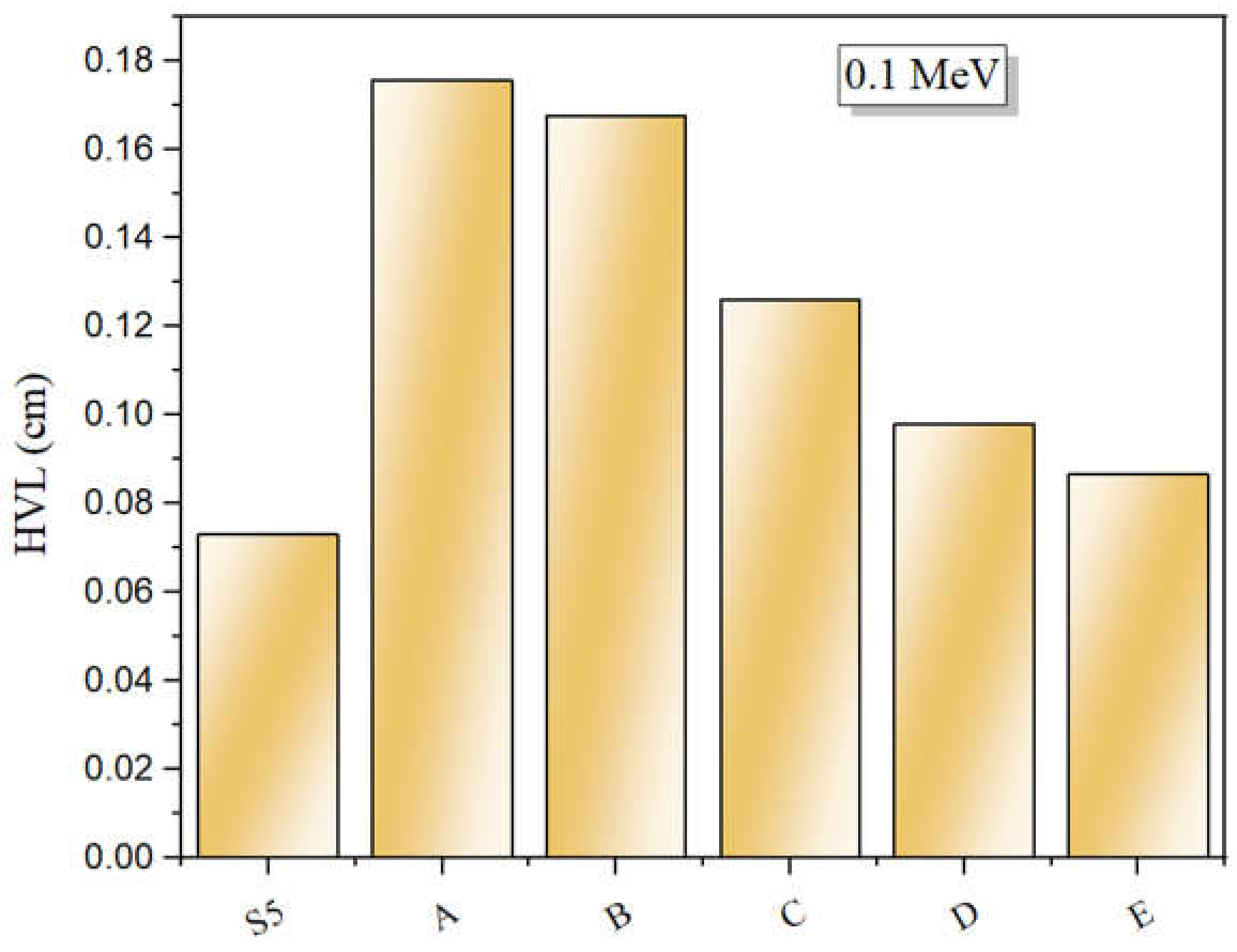
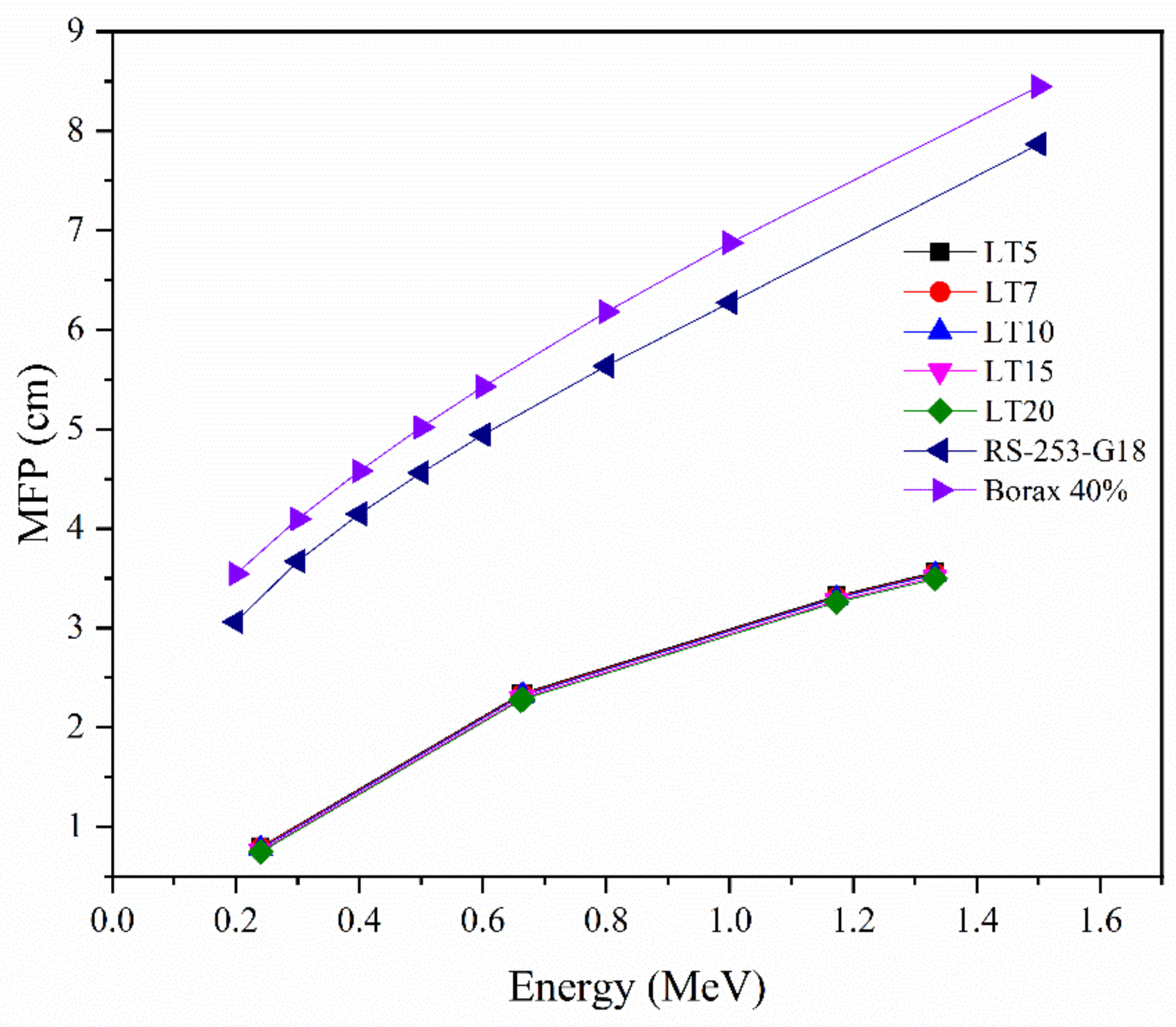
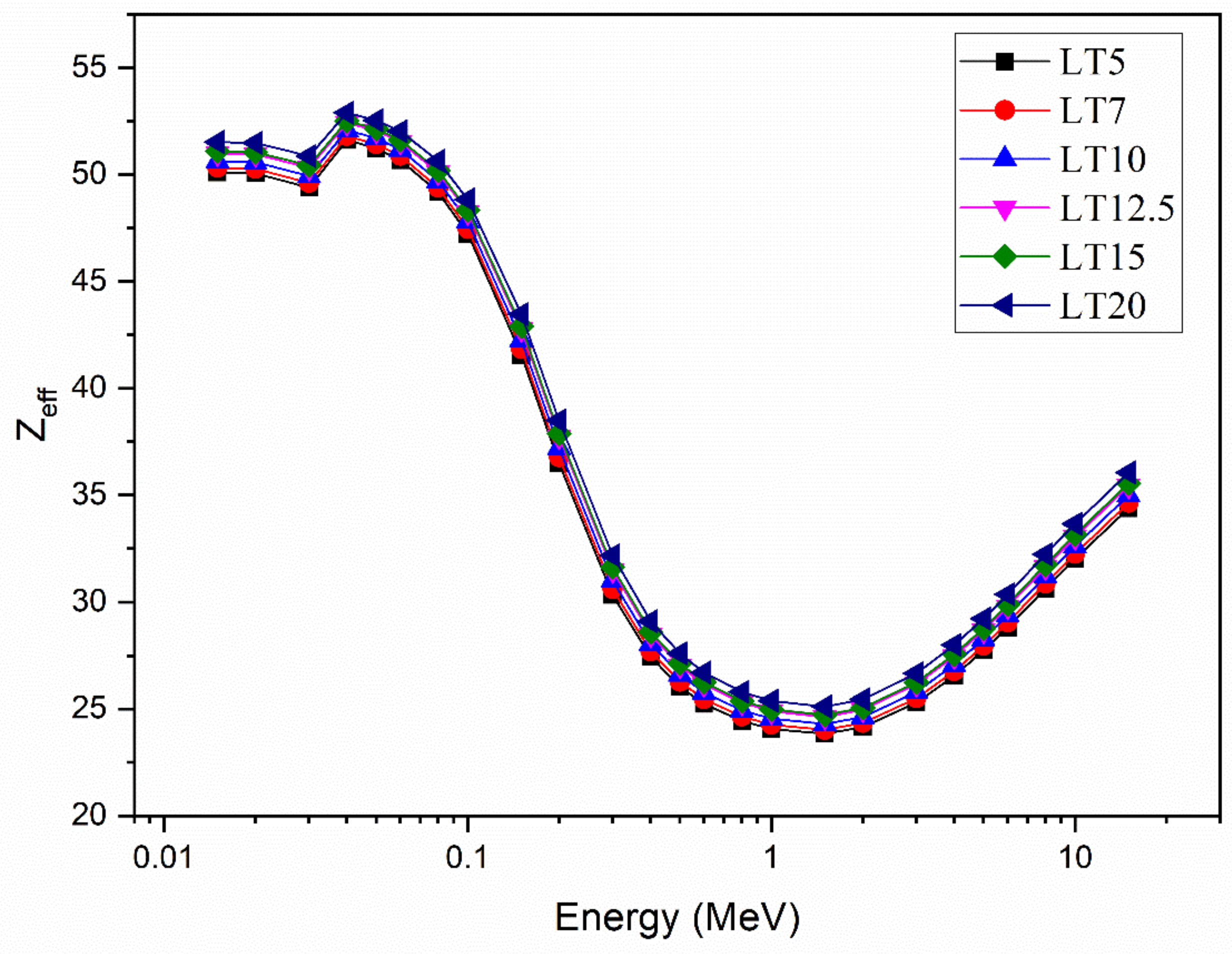
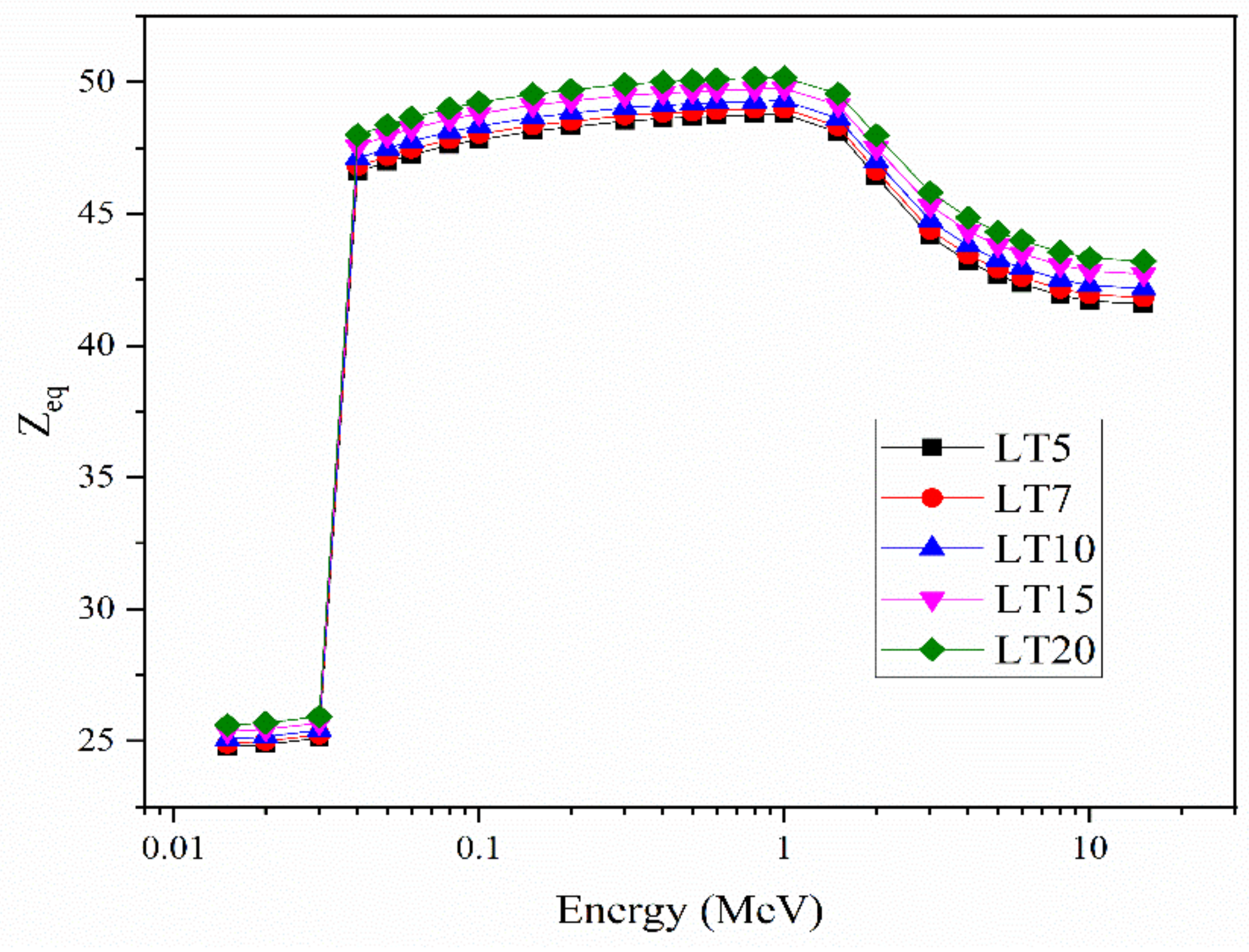

| Glass Code | La2O3 | TeO2 | Density | Molecular Weight |
|---|---|---|---|---|
| – | – | – | g cm−3 | g mol−1 |
| LT5 | 9.7 | 90.3 | 5.67 | 167.91 |
| LT7 | 13.3 | 86.7 | 5.69 | 171.23 |
| LT10 | 18.5 | 81.5 | 5.7 | 176.22 |
| LT15 | 26.5 | 73.5 | 5.74 | 184.53 |
| LT20 | 33.8 | 66.2 | 5.76 | 192.84 |
| Energy | LT5 | LT7 | LT10 | ||||||
|---|---|---|---|---|---|---|---|---|---|
| MCNP5 | XCOM | diff (%) | MCNP5 | XCOM | diff (%) | MCNP5 | XCOM | diff (%) | |
| 0.24 | 0.23 | 0.22 | 3.02 | 0.23 | 0.22 | 2.97 | 0.23 | 0.23 | 2.90 |
| 0.66 | 0.08 | 0.08 | 0.30 | 0.08 | 0.08 | 0.30 | 0.08 | 0.08 | 0.30 |
| 0.67 | 0.07 | 0.08 | 0.31 | 0.08 | 0.08 | 0.31 | 0.08 | 0.08 | 0.31 |
| 1.17 | 0.05 | 0.05 | 1.70 | 0.05 | 0.05 | 1.72 | 0.05 | 0.05 | 1.74 |
| 1.33 | 0.05 | 0.05 | 1.42 | 0.05 | 0.05 | 1.42 | 0.05 | 0.05 | 1.43 |
| Energy | LT12.5 | LT15 | LT20 | ||||||
|---|---|---|---|---|---|---|---|---|---|
| MCNP5 | XCOM | diff (%) | MCNP5 | XCOM | diff (%) | MCNP5 | XCOM | diff (%) | |
| 0.24 | 0.24 | 0.23 | 3.08 | 0.24 | 0.23 | 3.07 | 0.24 | 0.23 | 2.76 |
| 0.66 | 0.08 | 0.08 | 0.30 | 0.08 | 0.08 | 0.30 | 0.08 | 0.08 | 0.31 |
| 0.67 | 0.08 | 0.08 | 0.32 | 0.08 | 0.08 | 0.31 | 0.08 | 0.08 | 0.31 |
| 1.17 | 0.05 | 0.05 | 1.74 | 0.05 | 0.05 | 1.75 | 0.05 | 0.05 | 1.78 |
| 1.33 | 0.05 | 0.05 | 1.45 | 0.05 | 0.05 | 1.45 | 0.05 | 0.05 | 1.48 |
Publisher’s Note: MDPI stays neutral with regard to jurisdictional claims in published maps and institutional affiliations. |
© 2021 by the authors. Licensee MDPI, Basel, Switzerland. This article is an open access article distributed under the terms and conditions of the Creative Commons Attribution (CC BY) license (https://creativecommons.org/licenses/by/4.0/).
Share and Cite
Almuqrin, A.H.; Hanfi, M.; Mahmoud, K.G.; Sayyed, M.I.; Al-Ghamdi, H.; Aloraini, D.A. The Role of La2O3 in Enhancement the Radiation Shielding Efficiency of the Tellurite Glasses: Monte-Carlo Simulation and Theoretical Study. Materials 2021, 14, 3913. https://doi.org/10.3390/ma14143913
Almuqrin AH, Hanfi M, Mahmoud KG, Sayyed MI, Al-Ghamdi H, Aloraini DA. The Role of La2O3 in Enhancement the Radiation Shielding Efficiency of the Tellurite Glasses: Monte-Carlo Simulation and Theoretical Study. Materials. 2021; 14(14):3913. https://doi.org/10.3390/ma14143913
Chicago/Turabian StyleAlmuqrin, Aljawhara H., Mohamed Hanfi, K. G. Mahmoud, M. I. Sayyed, Hanan Al-Ghamdi, and Dalal Abdullah Aloraini. 2021. "The Role of La2O3 in Enhancement the Radiation Shielding Efficiency of the Tellurite Glasses: Monte-Carlo Simulation and Theoretical Study" Materials 14, no. 14: 3913. https://doi.org/10.3390/ma14143913
APA StyleAlmuqrin, A. H., Hanfi, M., Mahmoud, K. G., Sayyed, M. I., Al-Ghamdi, H., & Aloraini, D. A. (2021). The Role of La2O3 in Enhancement the Radiation Shielding Efficiency of the Tellurite Glasses: Monte-Carlo Simulation and Theoretical Study. Materials, 14(14), 3913. https://doi.org/10.3390/ma14143913









